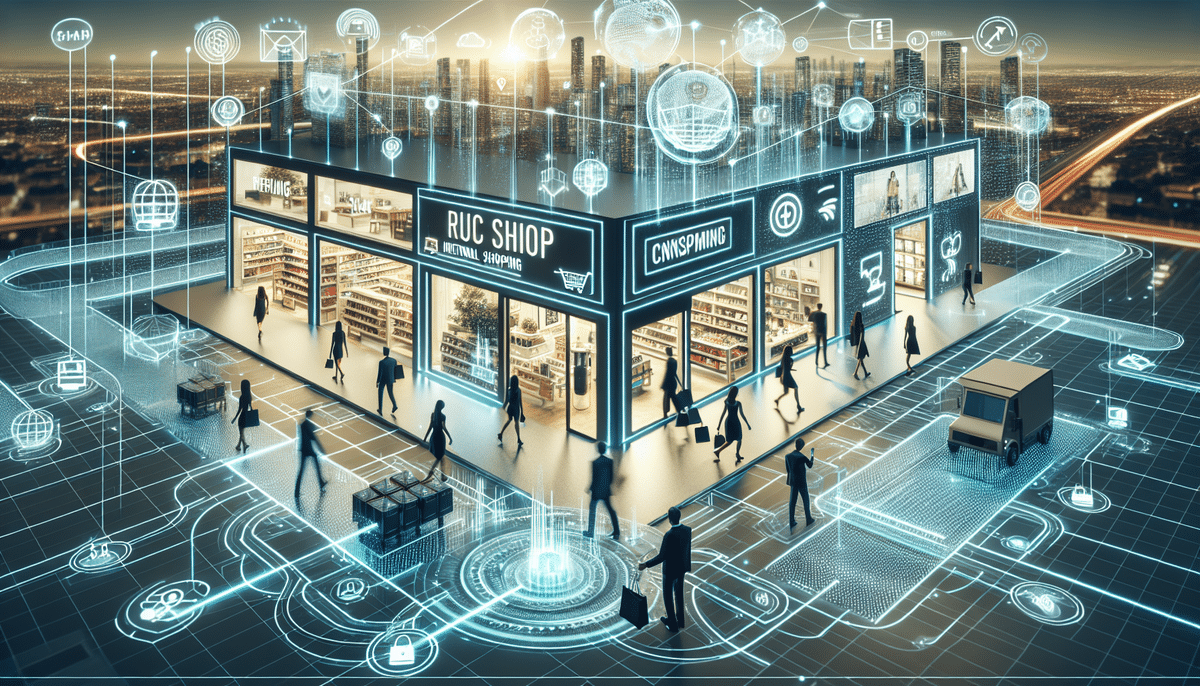Omnichannel Ecommerce: The New Standard for Multichannel Retail
In the dynamic landscape of retail, the rise of technology and eCommerce has fundamentally transformed the industry. Until recently, multichannel retailing, where businesses sold products through various channels such as brick-and-mortar stores, catalogues, and websites, was the prevailing standard. However, as customer expectations continuously evolve, retailers have had to adapt by adopting a more integrated approach known as omnichannel retailing. According to a 2023 Forrester report, over 80% of leading retailers have shifted towards omnichannel strategies to enhance customer experiences.
Understanding the Difference Between Multichannel and Omnichannel Retail
Before delving deeper into the advantages of omnichannel retailing, it is essential to understand how it differs from multichannel retailing. While multichannel retailing revolves around the use of various channels to sell products, including physical stores, websites, and mobile applications, omnichannel retailing takes this a step further by integrating all of those channels seamlessly.
Instead of treating each channel as a separate entity, omnichannel retailing treats them as a single cohesive ecosystem. This means that when a customer visits a physical store, their experience is interconnected with their online shopping journey. By leveraging omnichannel retailing, businesses can deliver a more cohesive and seamless experience to their customers, no matter which channel they use.
One of the key benefits of omnichannel retailing is that it allows businesses to collect and analyze data from all channels. This data can then be used to gain insights into customer behavior and preferences, which can inform marketing and sales strategies. For example, if a customer frequently browses a particular product category on the website but never makes a purchase, a business can use this information to send targeted promotions or recommendations to that customer via email or social media. According to a McKinsey study, personalized marketing campaigns can lead to a 15% increase in sales and significantly boost customer loyalty.
The Benefits of Omnichannel Ecommerce for Retailers
Maintaining a strong online presence is essential for retailers in today's competitive market. However, the benefits of an omnichannel eCommerce approach extend far beyond mere visibility. Brands that embrace omnichannel retailing can deliver a more consistent experience to their customers, enhancing customer loyalty and lead generation.
- Consistent Branding: Ensures a uniform brand message and experience across all channels.
- Enhanced Customer Data: Creates robust customer profiles by aggregating data from multiple touchpoints.
- Increased Customer Engagement: Reaches customers through their preferred channels, be it social media, mobile apps, or physical stores.
- Operational Efficiency: Optimizes inventory management and supply chain processes through integrated systems.
Furthermore, omnichannel retailing helps create comprehensive customer data profiles that allow retailers to gain a deeper understanding of their target consumers. This enables retailers to tailor their services to each individual customer’s interests and preferences, increasing the chances of repeat purchases and fostering long-term loyalty.
Additionally, an omnichannel approach allows retailers to engage customers through multiple channels, enhancing the overall shopping experience. By leveraging data collected from each channel, retailers can optimize their marketing strategies and improve their overall business performance. According to Statista, omnichannel retail sales are projected to reach $6.5 trillion by 2025, underscoring its critical role in future business strategies.
How Omnichannel Retailing Can Improve the Customer Experience
The customer experience is at the heart of retailing. With so many options available to consumers today, brands need to focus on building strong relationships with their customers. Omnichannel retailing helps businesses achieve this by offering a cohesive and integrated shopping experience across all channels.
For example, a customer browsing products online can place items in their cart and later pick them up from their local physical store. During the checkout process, the customer can use a mobile application to locate the nearest store and check product availability. When they arrive at the physical store, their order is ready, and they can quickly complete the purchase in person, leaving with their items in hand seamlessly.
In addition to the convenience of online shopping and in-store pickup, omnichannel retailing also allows for personalized marketing and communication with customers. By tracking a customer's shopping behavior across all channels, businesses can tailor their marketing efforts to the individual's preferences and needs. This includes targeted email campaigns, personalized product recommendations, and even customized in-store experiences, all of which contribute to a more engaging and satisfying customer journey.
Implementing an Effective Omnichannel Strategy for Your Business
Creating an effective omnichannel strategy requires careful planning, strong partnerships, and significant investments in technology. Here are key steps to consider:
- Integrate All Channels: Ensure that all sales and communication channels are fully integrated. This involves synchronizing inventory, sales data, and customer information across platforms.
- Invest in Technology: Implement advanced CRM systems and data analytics tools to track and analyze customer interactions across all touchpoints.
- Prioritize Customer Experience: Design the customer journey to be seamless and consistent, offering personalized experiences and multiple communication options.
- Maintain Flexibility: Stay adaptable to new technologies and evolving customer behaviors to continuously refine and enhance your omnichannel approach.
Additionally, businesses must invest in technology that can track customer data across all channels. This data can be used to identify trends, preferences, and conversion rates that inform future marketing and sales efforts. According to a Salesforce report, retailers who effectively utilize customer data see a 10-15% increase in sales growth.
The Role of Technology in Successful Omnichannel Ecommerce
The integration of technology plays a fundamental role in the success of omnichannel retailing. Advanced technologies enable retailers to provide real-time information to customers, enhancing their shopping experience. For example, real-time inventory management systems allow customers to instantly access information about product availability and delivery options, enabling informed purchasing decisions across various channels.
Personalization is another critical aspect of omnichannel eCommerce. By leveraging technology, brands can utilize data collected from multiple channels to offer personalized recommendations, thereby improving the overall customer experience and increasing retention rates.
Furthermore, technologies such as augmented reality (AR) and virtual reality (VR) are transforming the omnichannel retail experience. AR and VR allow customers to visualize products in a more immersive way, aiding in more informed purchasing decisions. For instance, a customer can use AR to see how a piece of furniture would look in their home before making a purchase, or utilize VR to experience a product within a virtual environment.
Moreover, technology enables retailers to streamline their supply chain and inventory management processes. Utilizing data analytics and automation tools, retailers can optimize inventory levels, reduce waste, and improve overall efficiency. This not only benefits the retailer by enhancing operational performance but also ensures that products are consistently available to customers, thereby improving satisfaction and loyalty.
Case Studies: Examples of Successful Omnichannel Retailers
Numerous retailers exemplify the successful implementation of omnichannel strategies, providing valuable insights into effective omnichannel practices:
- Macy's: Macy's integrates seamless in-store experiences with an advanced online platform. Their website extends the in-store experience by allowing customers to manage shopping information and preferences, encouraging store visits through exclusive online features.
- Sephora: Sephora engages customers across multiple channels throughout the purchase journey. Customers can test samples in-store, log details online, and complete purchases via the website or mobile app, earning loyalty points redeemable across all channels.
- Nike: Nike's omnichannel strategy allows customers to shop online, in-store, or through their mobile application with ease. Their platforms offer personalized recommendations based on browsing and purchase history, interactive in-store displays, and services such as free shipping and returns across all channels.
These case studies demonstrate how integrating various channels can lead to enhanced customer experiences, increased loyalty, and improved sales performance.
Challenges to Overcome When Adopting an Omnichannel Approach
Adopting an omnichannel approach presents several challenges that businesses must address to ensure successful implementation:
- Data Management: Managing and synchronizing data across various channels is complex. Ensuring data accuracy and real-time updates is critical for providing a seamless customer experience.
- Integration Efforts: Keeping all channels integrated requires continuous effort, collaboration across departments, and the ability to adapt systems as needed.
- Technology Investments: Significant investments in the right technology infrastructure are necessary to support omnichannel operations. This includes CRM systems, data analytics tools, and automation solutions.
- Consistent Branding: Maintaining consistent messaging and branding across all channels is essential. This requires a deep understanding of the target audience and the ability to tailor messaging appropriately while preserving a cohesive brand identity.
- Adaptability: Businesses must be prepared to adapt to changing consumer behaviors and preferences. As new channels emerge and existing ones evolve, companies must remain agile to stay competitive.
Addressing these challenges involves strategic planning, investment in technology, and fostering a culture of collaboration and adaptability within the organization.
Tips for Creating a Seamless Shopping Experience Across Channels
Creating a seamless shopping experience across channels necessitates a customer-centric approach. Here are some actionable tips:
- Understand Customer Behavior: Analyze how your target customers interact with your business across multiple channels. Identify patterns and insights that drive their behavior and preferences.
- Leverage Technology: Utilize advanced CRM and data analytics tools to provide real-time data and personalized engagement across all channels.
- Ensure Consistent Branding: Maintain a consistent brand message and aesthetic across all touchpoints to reinforce brand identity.
- Optimize Mobile Experience: With the increasing use of mobile devices for shopping, ensure that your mobile platforms are user-friendly and optimized for all devices.
- Implement Unified Inventory Management: Use integrated inventory systems to provide accurate product availability information across all channels.
- Regularly Test Integrations: Continuously test and refine your channel integrations to identify and resolve any issues, ensuring a smooth customer journey.
By focusing on these strategies, businesses can significantly enhance the shopping experience, leading to higher customer satisfaction and increased sales.
The Future of Retail: Why Omnichannel is Essential to Stay Competitive
The future of retail is undeniably omnichannel. As consumer behaviors and technological advancements continue to evolve, businesses must recognize that omnichannel eCommerce is not just an advantage but a necessity to remain competitive. Customers increasingly expect sophisticated and interconnected shopping experiences that seamlessly blend online and offline interactions.
According to a Bain & Company report, retailers who effectively implement omnichannel strategies are more likely to thrive in an increasingly competitive market. These strategies enable businesses to meet customer expectations, enhance brand loyalty, and drive sustained growth.
Moreover, with the rise of technologies such as artificial intelligence and machine learning, the potential for hyper-personalized customer experiences is expanding. Retailers that embrace these technologies within their omnichannel frameworks will be better positioned to anticipate and meet the needs of their customers, ensuring long-term success.
Common Mistakes to Avoid When Implementing an Omnichannel Strategy
While the benefits of an omnichannel strategy are significant, businesses must navigate potential pitfalls to ensure successful implementation. Here are common mistakes to avoid:
- Ignoring Internal Strengths and Weaknesses: Failing to assess your business's strengths, weaknesses, and readiness can lead to ineffective strategy execution.
- Incomplete Channel Integration: Not fully integrating each channel can cause logistical difficulties and miscommunications, disrupting the customer experience.
- Underestimating Data Management: Inadequate investment in robust data management systems can hinder the ability to track and utilize customer data effectively.
- Lack of Employee Training: Employees must be properly trained to use new systems and understand the omnichannel strategy to ensure smooth operations.
- Inconsistent Messaging: Providing inconsistent messaging and branding across channels can confuse customers and dilute brand identity.
To avoid these mistakes, businesses should conduct thorough assessments, invest in the necessary technology, and ensure continuous training and alignment across all departments. Regularly reviewing and refining the omnichannel strategy based on performance metrics and customer feedback is also crucial for sustained success.
Measuring Success: Metrics and KPIs for Evaluating Your Omnichannel Strategy
Evaluating the success of an omnichannel strategy requires the analysis of a comprehensive set of Key Performance Indicators (KPIs) and metrics. Here are essential metrics to consider:
- Sales by Channel: Track sales performance across different channels to identify which are most effective.
- Conversion Rate: Measure the percentage of visitors who make a purchase, providing insight into the effectiveness of your sales funnel.
- Customer Retention Rate: Assess the ability to retain customers over time, indicating loyalty and satisfaction.
- Customer Lifetime Value (CLV): Evaluate the total revenue a business can expect from a single customer account, reflecting long-term profitability.
- Traffic by Channel: Monitor the volume of traffic each channel generates to understand customer preferences and behavior.
- Average Purchase Frequency: Determine how often customers make purchases, indicating engagement and satisfaction.
Retailers must regularly monitor and analyze these metrics to ensure their omnichannel strategy is delivering the desired outcomes. According to a Smart Insights guide, continuous improvement based on data-driven decisions is key to maintaining a seamless and integrated shopping experience across all channels.
Overall, omnichannel eCommerce has solidified its position as the new standard for multichannel retailing. By integrating various channels into a seamless consumer journey, businesses can build stronger relationships with their customers, generate qualified leads, and enhance their brand image. However, implementing an effective omnichannel strategy requires meticulous planning, substantial investment in technology, and a commitment to continuous adaptation and innovation.






















